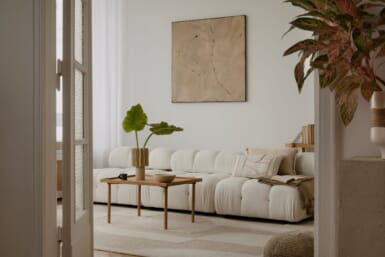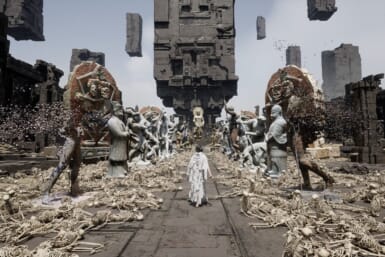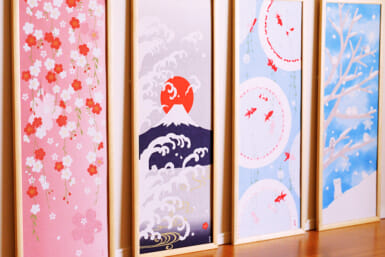Hussein Chalayan, Russian Doll (National Art Center Tokyo)
Where does fashion fit into the art spectrum? I suppose that the answer can at least be partially gleaned from the fact that people such as Hussein Chalayan, Issey Miyake and Patrick Mohr are labeled fashion “designers,” putting it in much the same uncomfortable grey zone as design in general. It is a practical art, but one that contributes as many negatives to society as positives. While product designers might be responsible for fueling mindless consumption, fashion designers and fashion shows take some responsibility for giving women unreachable aesthetic goals and a resultant dose of self-loathing. That makes ninety-nine percent of it problematic for me. But there is that one percent…
I remember it well. It was August 2007. The National Art Gallery had opened that winter, but was now showing Skin + Bones: Parallel Practices in Fashion and Architecture, an exhibition organized by curator Brooke Hodge. The show’s catalogue to this day maintains a place of honor on my bookshelf, partly because it’s just so darn huge, and partly because it remains the measure, as far as I’m concerned, of what a good curator can really achieve.
The title of the show had made me snort at first. Fashion and architecture? Pah! Why not compare apples and operas? I was certain it would be a frivolity. But when I came out, I felt I had seen a visual essay — a show that laid out its ideas, followed a line of logic, and by the end had me wondering how I had never seen the intimate relationship between these two things before. All of this without cloying, crowd-pandering write ups, or interactive computerized exhibits. The show changed the way I looked at group exhibitions. And it changed the way, at least to an extent, that I looked at fashion design.
Now, don’t get me wrong. I like fashion. I couldn’t care less about brands, but I’m very conscious of trends, particularly on the street, because they can reveal things about a society and its values. But high-fashion runway shows where stick-thin models wear clothes that no one would be caught dead in on the street? They baffled me. What were they? They don’t represent living fashion. They don’t represent anything that anyone cares about aside from other people involved in the industry, as far as I could see.
But while most fashion designers are out to find that “look” that will sell or cause a stir, there is a minority out to question the limits of fashion, and draw in politics as well. It’s a rocky area to be in. The fact of the matter is that the fashion industry has long been focused on women, and has fed off of their objectification. Those working in it aren’t in much of a position to pontificate.
But still some go up against the norm. Hussein Chayalan, with his Turkish Cypriot roots but very secular ethics, took the Muslim chador to task, creating a line of this less-extreme cousin to the niqab that varied in length from floor-sweeping to just covering the face. He then displayed it with his models naked underneath. It was not only a slap in the face to religious conservatism and a statement of absurdity, but one that also said, “Here she is, this woman whose body you are so afraid of. She is just a simple human.” Of course, there is the fact that she is still a super-thin model…but I guess we choose our battles.
Chayalan (who had several works at the Skin + Bones show, and whose solo exhibition ran until last month at the Museum of Contemporary Art Tokyo) has done furniture that became skirts, and the wonderful “Russian Dolls” dress: a series of layers that, when fully worn, almost completely obscure the wearer. It is a mountain of clothes that hearkens not only the nature of clothes used to hide nakedness, but the very old roots of fashion practice that led aristocrats to show off their wealth by wearing clothing made with ridiculous amounts of fabric. Today’s wedding dresses, prom dresses and formal wear still show influences from this.
But what led me to thinking of all of this today was a video of Patrick Mohr’s recent show in Berlin. (Since I can’t seem to embed it, you’ll just have to follow the link above. It’s very worth watching.
Yes. The models have beards. Both the men and women are bald and bearded; the clothes a strange kind of baggy and androgynous fashion that leaves no real need to differentiate between the sexes.
Mohr is a young designer known for surprising runway shows. In 2009, he included homeless people on the runway along with regular models, and he almost inevitably de-sexualizes his models — or makes them downright ridiculous. I wouldn’t go so far as to call him a feminist designer, but the reactions he gets speak for themselves.
People find the shows wacky. Audiences can’t comprehend why he would want to make “beautiful” models so ugly. And it isn’t just the women. He plays with masculine concepts as well. (He once used bulky bodybuilders as his male models, rather than the usual buff-but-thin boys usually found on runways.) And the fact that so many people still don’t get it tells me he’s hitting his point bang-on. For Mohr, fashion is clothing — the beauty of the model, his or her thinness or hair, should not be a factor. He redesigns his models to be abstractions, and in the Berlin show, even the gender distinction between the clothes being shown is up for question.
And that is where fashion comes closest to art.
But exactly how that happens still raises questions for me that I’m nowhere near to answering. Does the insertion of the designer’s pet political issue simply make it art? Surely not. Overt politics are seldom pretty in the gallery, and polemics are better treated on paper than on the runway. Is Mohr just abusing an issue to draw attention to his work? It’s a tried-and-true technique, after all. And how much good can really be done from within an industry so steeped in misogyny anyway? Like product designers doing works that question capitalism, there are unsettling ethical issues in every direction that keep my enthusiasm from getting too out of hand.
But still, if just one person in that audience questions their gender assumptions for the first time, it would surely be a win.










